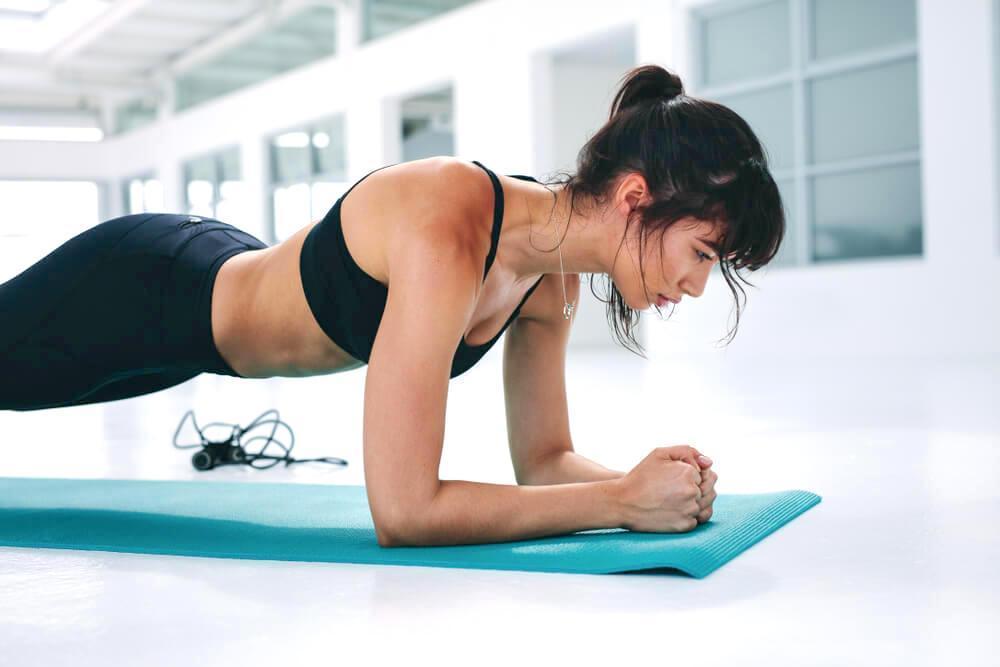
Resistance training, which is also referred to as strength training, consists of exercises that make use of a form of force to “resist” your movement.
This helps in building:
- Muscle size
- Strength
- Endurance
There are so many strength training exercises out there, with each one targetting different parts of the body.
When it comes to developing stronger arms, here are the 11 best resistance exercises to try.
Dumbbell Pullover
The dumbbell pullover is a move that not only gives your arms and shoulders a workout, but also your back and your chest, targeting your entire upper body.
To do this exercise, you will need a weight, such as a medicine ball. Try to use one that weighs at least 2kg. This may not seem like much, but you can slowly increase it as your arms get stronger.
Lie with your back on a mat, bending your knees and keeping them about shoulder width apart. Hold the ball above your chest, keeping your arms stretched out but with your elbows just slightly bent.
Inhale slowly and bring the ball backwards over your head, so that your arms have lined up with your body. Exhale, before returning your arms to their original position over your chest.
Wondering if you can use a dumbbell instead?
Yes, but make sure that you hold it horizontally with your hands on either end.
Bench Dips
This is another exercise that targets the triceps, and requires a chair for support.
Begin by sitting down, keeping your hands on the chair edges on each side of your body. Slowly move your feet forwards, until you are slightly lifted off the chair. Keeping your knees apart, about the same width as your hips, and bent at 90 degrees, lower yourself down by bending your arms to the same angle. Then, push yourself back up and repeat, taking care not to thrust your hips while you are doing so.

Finding this one too difficult?
Try doing this exercise without using a chair, simply placing your hands on the floor instead.
On the other hand, if you want the exercise to be more difficult…
Keep your legs straight throughout, rather than bending them at a 90 degree angle. If you’re outdoors, you can also choose to do this on steel railings or bars.
Bicep Curls
As you can tell from their name, bicep curls exercise the bicep muscles, and are a great exercise to do after the push ups mentioned earlier.
How do you do them?
By following these steps:
- Standing up, hold a dumbbell in each hand, with your hands down by your sides and your palms facing forwards
- Bend your elbows, taking care not to move your upper arms while you’re doing so, and curl the dumbbells up towards your shoulders
- Pause before lowering the weights back down to your original position, making sure that your arms are straight
One mistake that many make with this exercise is…
Holding the dumbbell handles way too tightly. Try to loosen your grip, focussing instead on squeezing your biceps each time you move your elbows upwards, as though you are crushing something in the crease where they are bending.
Overhead Barbell Press
The overhead barbell press is an exercise that targets just about every part of your shoulder. This is quite a tough one, due to the way in which it requires you to lift a weight high up over your head, so opting for a weight that is lighter than what you usually lift may be a safer bet.
This is an exercise best done standing up, although you may need to sit on a chair with some back support if you are using a heavier weight.
Ready to get started?
Follow these steps:
- Hold the barbell bar, keeping your hands just slightly wider than shoulder width
- Slowly bring the bar up to your forehead, bending your elbows as you do so
- Press the weight up above your head, making sure to keep your back straight and your abs contracted. Be careful not to lock your elbows once your arms have straightened up
- Exhale slowly before returning your arms back to their original position, and then repeating these steps
A common variation to this exercise is lifting the bar up and behind the neck, but this is something that you shouldn’t attempt.
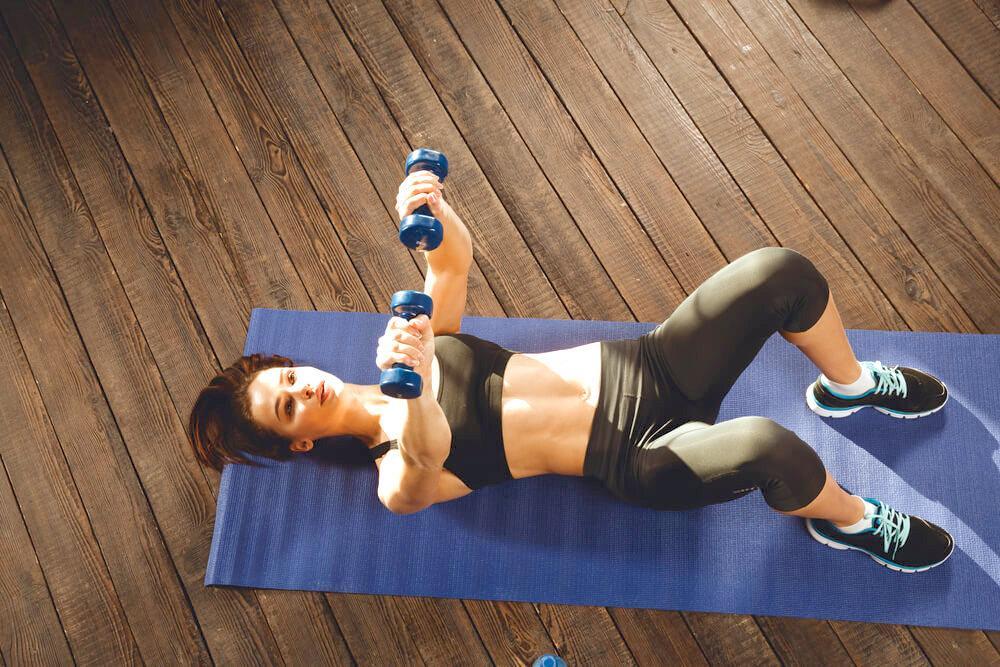
Why?
Because this version often leads to strained muscles in the rotator cuff and neck. If you follow the steps above instead, this targets the muscles in your shoulders without putting any unnecessary pressure on them.
The Skull Crusher
The Skull Crusher may sound a little scary, but this is a fantastic workout for your arms.
You will need dumbbells for this one, keeping one dumbbell in each hand while you lie on your back, bending your knees.
Raise your arms up over your chest, keeping your elbows straight, before lowering your arms down to your head.
Aim to place your dumbbells on either side of your head, with your elbows bent. Then, lift your arms back up to their original position, before repeating 30 times.
The Plank
The plank is an exercise that primarily targets your core by building isometric strength, but also exercises your arms too.
Ideally, you should be able to hold a plank for at least a minute.
If you can’t…
This means that you will struggle with many of the other exercises on this list. By working on your core, this will help to prepare your body for exercises that are more difficult.
How do you do a plank?
Simply place your body into the push up position, with your palms about shoulder-width apart. Pull your stomach in towards your spine, making sure that it doesn’t either drop down or stick up. This is what engages your core.
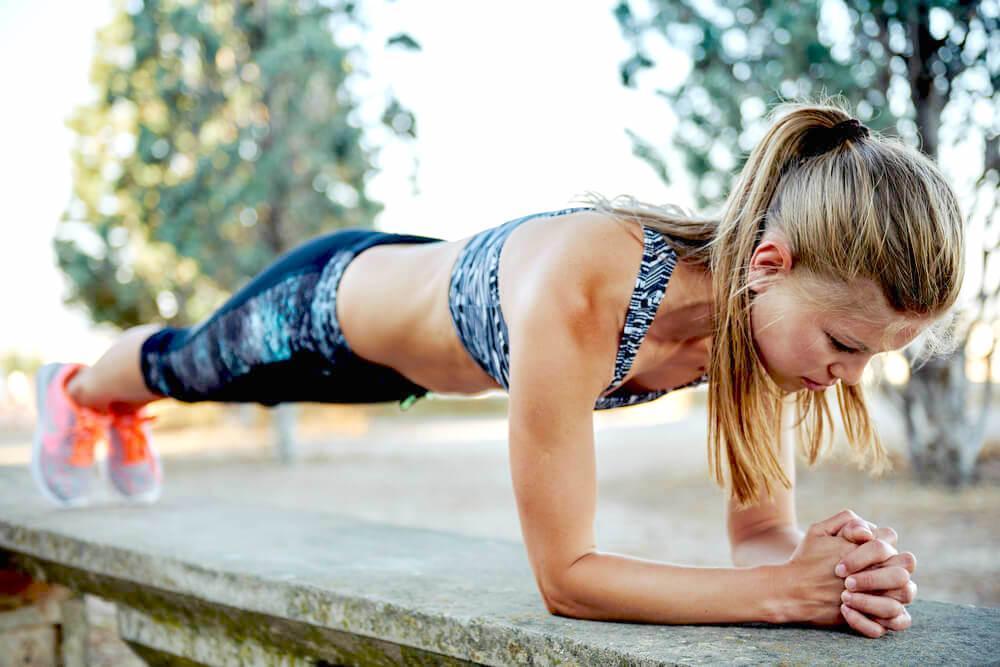
If you are new to working out, aim to hold the plank for 30 seconds, building on this over time.
Bent Over Front Raise
This is a great exercise for toning the arms, since it targets the shoulders, biceps and the triceps all at once.
All you need to do is:
- Squat down as low as you can and then get up, making sure that your back doesn’t curl
- Have your arms straight out in front of you and place a dumbbell in each hand
- Lift your arms so that the dumbbells are over your head, making sure to keep your body posture steady and your elbows straight
- Return your arms to their original position, before repeating
Lateral Raises
Lateral raises focus on the shoulders, while also working out your upper back. There are quite a few variations to this exercise, making it a great one to tailor to your needs.
You will need either a chair or a ball to sit on for this exercise.
Which one would be more beneficial?
That depends on how difficult you want the exercise to be…
A ball is a more unstable surface, and this makes the exercise more intense.
Sit on the ball or chair, with a weight in each hand and your elbows bent at 90 degree angles. Holding your elbows in this position, lift your arms upwards and outwards, so that they are level with your shoulders. Return your arms back down to their original position and then repeat.
If you want to make this even more challenging…
Keep your arms straighter when you raise them, giving them just a slight bend rather than holding them at a 90 degree angle.
Make sure that while doing this exercise, you are contracting your abs and keeping your back straight.
Close Hand Push Ups
Push ups are one of the best resistance training exercises out there, and since they don’t overload the muscles, they are ideal for anyone who is only just beginning with strength training.
When it comes to push ups, there are two main types out there:
- Close Hand – has the palm placed narrower than shoulder width, with both hands almost touching. This results in a better workout for the muscles in your triceps, but also places more stress on the wrist and elbows
- Wide Hand – has the palms placed wider than shoulder width, making it more comfortable

How do you do a close hand push up?
It’s easy…
Get down on your knees and place your hands right below your shoulders, before lowering your body so that your chest is almost touching the floor. Pause for a second before quickly pushing yourself back up to your original position.
While doing the exercise, make sure that you squeeze the muscles in your abs and glutes at the same time.
Why?
Because this will help to keep your body properly aligned.
Downward Facing Dog
While you may not think of the downward facing dog yoga position as a resistance training exercise, this is a fantastic one that targets multiple muscles, including your:
- Triceps
- Shoulders
- Spine
- Glutes
- Hamstrings
- Calves
In addition to stretching all of those muscles, this exercise also requires you to hold your hips up higher than your heart, which does fantastic things for your blood circulation.
Want to know how to do the downward facing dog?
It’s simple…
Get down on all fours, keeping your knees and your feet about hip width apart and your hands shoulder width apart. Spread your fingers out and press down firmly on your mat with your hands. Lift your knees up off the mat, until your legs are straight.
You will then need to shuffle your feet backwards and your hands forwards, so that you can get yourself into the right position. Once you get there, squeeze your thighs and keep your heels pressed down on the mat, making sure that your neck is relaxed.
You will need to hold this position for at least 60 seconds, building this up over time.
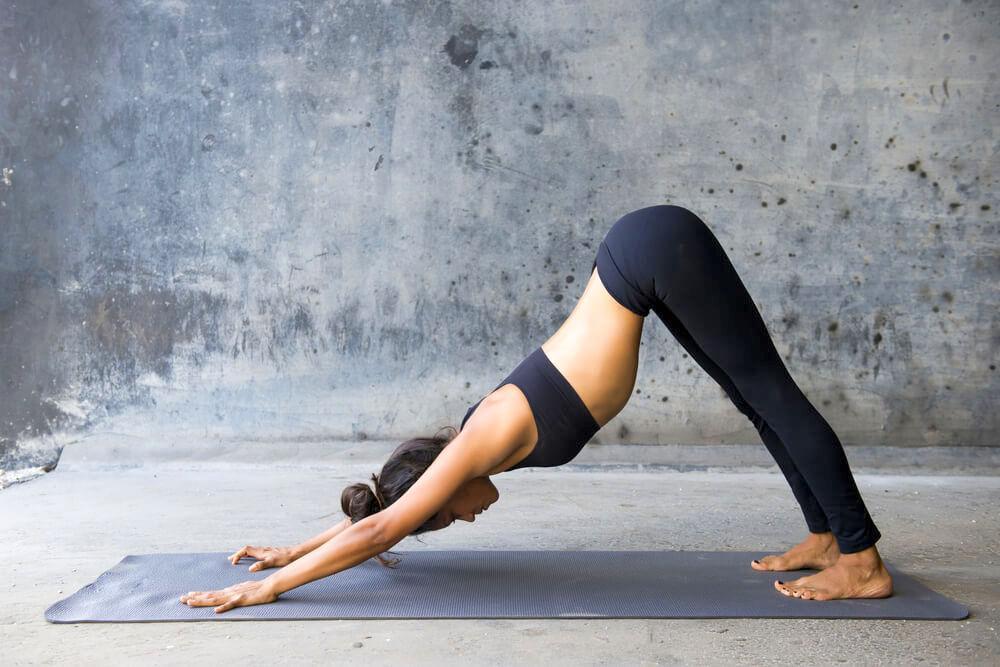
With this being a yoga pose, the exercise will be even more beneficial if you practice a breathing exercise at the same time.
Never done one before?
It doesn’t need to be anything complicated. Either way, you would need to breathe deeply while holding this pose. Try focussing in on the sensation of the breath entering your body and filling your lungs, before being slowly exhaled.
This technique is known as mindful breathing, and it brings with it several extra benefits, such as:
- Increases levels of leptin in the body, a hormone that helps with weight loss
- Improves stamina
- Extends lifespan by reducing chronic inflammation, which leads to everything from Alzheimer’s disease and cancer to heart disease and depression
- Promotes happiness and mental clarity
Don’t believe that?
Those benefits have all been scientifically proven, making mindful breathing well worth incorporating into parts of your workout routine.
Dumbbell Punches
Dumbbell punches work out just about every muscle in your arms, making this a great one for boosting general arm strength.
In addition to being a resistance exercise, dumbbell punches also count as cardio, making them a popular warm up exercise. While this exercise will work without the weights too, adding them in makes your muscles work that much extra, giving your arms a better workout.
How do you do a dumbbell punch?
Place a dumbbell in each hand, holding them up near your shoulders with your elbows close to your sides. Then, straighten out one elbow, as though you were punching the dumbbell forward. Bring this arm back in before repeating with the other arm.
Keep alternating between the two arms for between one to two minutes.
Wondering what dumbbell weight to go for?
Around three to five pounds is usually recommended, although this does depend on how much you can usually lift.
Resistance training is so effective when it comes to strengthening and toning the arms, and each of these exercises can be incorporated into a longer workout. Just remember – if you are new to resistance training, start off slow and light and gradually build on this as your arms, and the rest of your body, gets stronger.

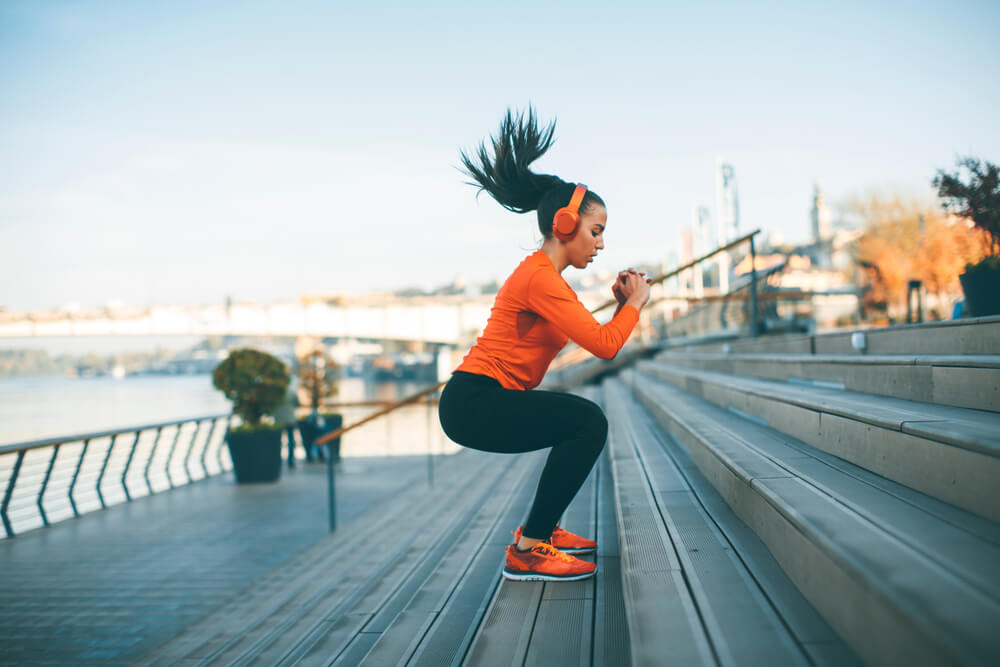
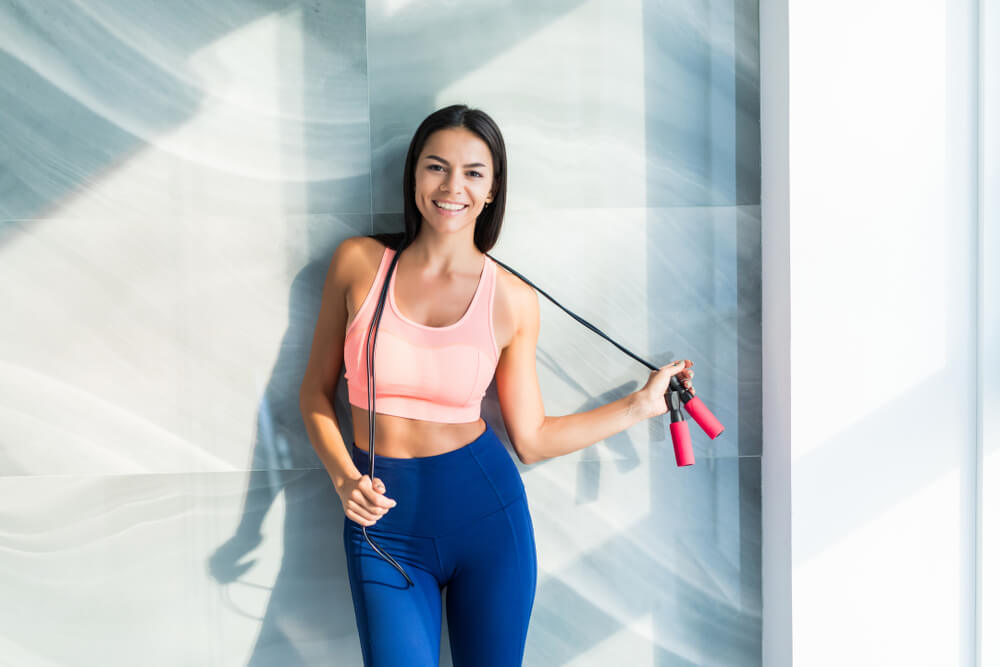


Leave A Comment